How to minimize hassle and maximize fun with a few simple tips
By Joe Mallard
Loren Keizer spends plenty of time on the water and ice, much of the time with his wife and kids.
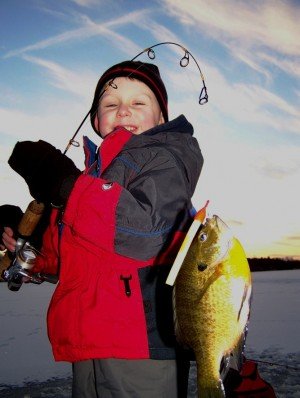
“For our family, fishing’s a lifestyle. Both my wife and I think it’s important to make sure our kids have every opportunity available to fish and be outdoors. And one of our favorite times is late ice. Fish get more active, the weather’s nicer and panfish opportunities are plenty.”
But, as anyone with kids can attest, there’s far more involved than jumping in the truck and driving to the lake. Longtime North American Fisherman editor Kurt Beckstrom once summed it up perfectly: “Remember, when you take kids fishing, it’s their fishing trip, not yours.”
Keizer’s approach echoes Beckstrom’s wise words. “One thing I’ve learned since taking my son out these last few years is that the focus turns from me to him. Forget about always needing to be the one to catch the fish. Take time to teach your kids how to enjoy the sport, understand electronics, set the hook, the basics of biology and conservation, etc. By focusing on them over you, you can create some lifelong memories you’ll share and talk about for years!”
Keizer has a host of recommendations that can spell more fun (and more fish) on the ice for any family.
Pre-ice prep
“Just like sending kids out to play in the snow, they need to have on the right apparel when heading out on the ice, even during late season.”
His check list includes waterproof boots, a warm coat and bibs/snowpants, waterproof gloves, wool socks and a warm hat. “But don’t be afraid to bring along extra boots, snowpants, gloves, socks and pants. If a foot makes it down the hole, your outing could be done in short order if you don’t have extra clothes to keep the kids dry and warm. Using bread bags as a boot liner isn’t a bad idea, either. That way, if they dunk a boot their socks stay dry.”
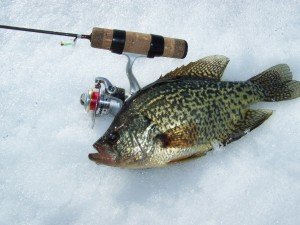
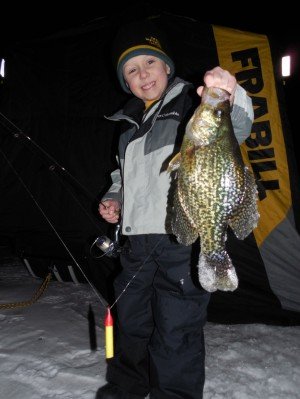
Second, Keizer advises bringing snacks—and lots o’ ‘em. “Just like being out in the boat during the warm weather months, snacks can keep an outing enjoyable and prolong the trip for another hour or two. We all know how calories can boost our energy levels when things don’t quite go as planned.”
As your budget allows, invest in or borrow additional fishing electronics for kids. “You don’t fish without ‘em, why should kids? My son loves having a flasher in the hole so he can ‘fish like dad.’ Plus, he’s learning how to read it! And an underwater camera can bring plenty of enjoyment, too. Help kids identify their bait and fish and you’ll surprised by how quickly they catch on the program!”
But Keizer admits that no matter what you do, some days their attention span just doesn’t hold. “Sometimes a quick pull on a sled, some snow football or a quick ride on an ATV or snowmobile is a good diversion until a late-afternoon or evening bite.”
Take shelter
“Kids do a good job of letting you know when they’re cold, but make sure to keep an eye on them. Sunny, calm days are great for fishing outside, which makes the experience that much more enjoyable, but sometimes you can’t pick the weather and that’s where a portable fish house comes in handy.”
He says pop-up “hub” style shelters, like the Frabill Ambush Outpost are light, compact and easy to put up or down and will fit into the trunk of a car. “Flip-over shelters, like the Frabill Ambush Side Step, are great, too, especially when used with an ATV or snowmobile. The side doors on the Side Step make it easy for the kids to get in and out of the house without having to walk over everything.”
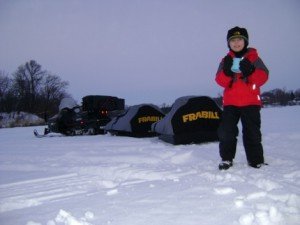
When it comes to heaters, Keizer’s a fan of Mr. Buddy products. “Since adding my boys to the ice fishing experience, safety definitely comes first. Unlike a sunflower heater, where the entire heater gets red hot, Buddy and Big Buddy heaters have a very limited area that gets hot and even that is protected with a grill. Plus, Buddy heaters automatically shut off if they get kicked or tripped over. This makes it safer for kids and your shelter.”
Location, location, location
After you’ve assembled all requisite gear for a family outing, Keizer says having a solid game plan of where to fish is key. As time allows, he recommends scouting areas ahead of time to eliminate unnecessary wandering around with kids to find fish.
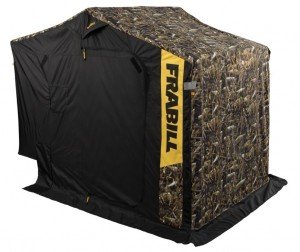
“For late-season panfish I tend to look for shallow weeds and flats with adjacent deep water. With more sunlight coming through to shallow waters, weed growth will start here first, reinvigorating aquatic life, much of it on the panfish menu. Some of the best places to look late-season are the same places you spot green weeds during early ice,” says Keizer.
“Also, if you’re new to ice fishing, don’t be afraid to go to community holes. But position yourself on the edges of the group, because a lot of time the intense fishing pressure pushes fish off to the sides of these groups, especially crappies. And that can mean some pretty steady action, even when the group of houses isn’t doing so hot.”
Presentation: Keep it simple, meatless
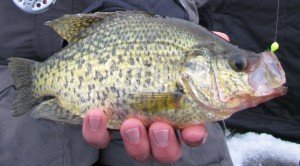
When it comes to presentation, Keizer’s a proponent of leaving live bait at home. “A Rat Finkee with a gold head and green body is my all-time favorite late-ice panfish bait. Ratsos and Shrimpos are great, too. Their lively soft-plastic bodies work great in shallow water and their fall is a bit slower than some of the other jigs out there. A small Chekai or Diamond Jig with a plastic tail is another great option. Great thing about all of these baits is you don’t need to worry about live bait, which helps keep the action going with kids!”
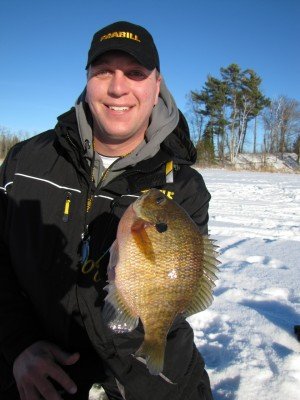
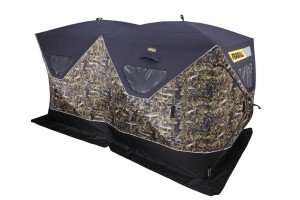
Parting advice
Keizer says that keeping kids warm, dry, entertained, and catching fish will help make some great memories for the future and instill a natural love for the sport.
“These early years are also great for getting kids started on the right foot with conservation. My oldest son, Lucas, is always asking about what fish we’re going to keep, why we need to throw some of the fish back, etc. I have had the opportunity to explain to him why we release larger fish to breed and maintain a healthy fishery. Same goes for not taking a limit of fish every time we go out. Over time, kids begin to understand the importance of conservation through example and explanation. Same goes for picking up after ourselves and others. I think it’s important to teach your kids how to respect and protect the resources we have.”
Keizer challenges families – even those new to ice fishing – to take some time this February and March to get kids out on the ice and enjoy the great fishing opportunities present across the Ice Belt.
“Remember, by making it more about them and less about you, you’re creating a fishing partner for life!”

